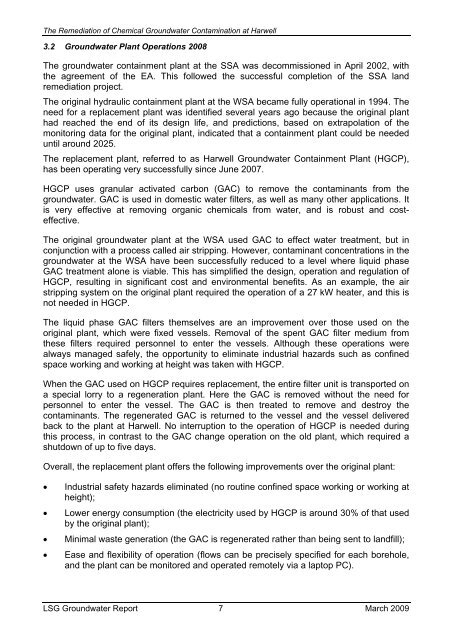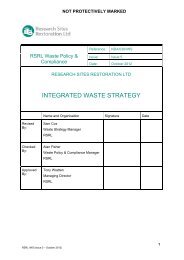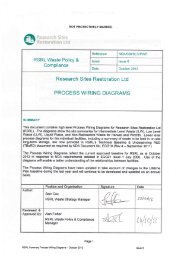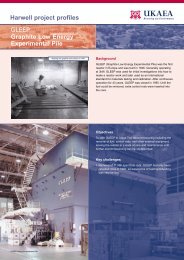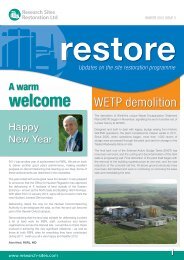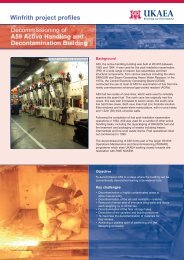The Remediation of Chemical Groundwater Contamination at Harwell
The Remediation of Chemical Groundwater Contamination at Harwell
The Remediation of Chemical Groundwater Contamination at Harwell
Create successful ePaper yourself
Turn your PDF publications into a flip-book with our unique Google optimized e-Paper software.
<strong>The</strong> <strong>Remedi<strong>at</strong>ion</strong> <strong>of</strong> <strong>Chemical</strong> <strong>Groundw<strong>at</strong>er</strong> <strong>Contamin<strong>at</strong>ion</strong> <strong>at</strong> <strong>Harwell</strong>3.2 <strong>Groundw<strong>at</strong>er</strong> Plant Oper<strong>at</strong>ions 2008<strong>The</strong> groundw<strong>at</strong>er containment plant <strong>at</strong> the SSA was decommissioned in April 2002, withthe agreement <strong>of</strong> the EA. This followed the successful completion <strong>of</strong> the SSA landremedi<strong>at</strong>ion project.<strong>The</strong> original hydraulic containment plant <strong>at</strong> the WSA became fully oper<strong>at</strong>ional in 1994. <strong>The</strong>need for a replacement plant was identified several years ago because the original planthad reached the end <strong>of</strong> its design life, and predictions, based on extrapol<strong>at</strong>ion <strong>of</strong> themonitoring d<strong>at</strong>a for the original plant, indic<strong>at</strong>ed th<strong>at</strong> a containment plant could be neededuntil around 2025.<strong>The</strong> replacement plant, referred to as <strong>Harwell</strong> <strong>Groundw<strong>at</strong>er</strong> Containment Plant (HGCP),has been oper<strong>at</strong>ing very successfully since June 2007.HGCP uses granular activ<strong>at</strong>ed carbon (GAC) to remove the contaminants from thegroundw<strong>at</strong>er. GAC is used in domestic w<strong>at</strong>er filters, as well as many other applic<strong>at</strong>ions. Itis very effective <strong>at</strong> removing organic chemicals from w<strong>at</strong>er, and is robust and costeffective.<strong>The</strong> original groundw<strong>at</strong>er plant <strong>at</strong> the WSA used GAC to effect w<strong>at</strong>er tre<strong>at</strong>ment, but inconjunction with a process called air stripping. However, contaminant concentr<strong>at</strong>ions in thegroundw<strong>at</strong>er <strong>at</strong> the WSA have been successfully reduced to a level where liquid phaseGAC tre<strong>at</strong>ment alone is viable. This has simplified the design, oper<strong>at</strong>ion and regul<strong>at</strong>ion <strong>of</strong>HGCP, resulting in significant cost and environmental benefits. As an example, the airstripping system on the original plant required the oper<strong>at</strong>ion <strong>of</strong> a 27 kW he<strong>at</strong>er, and this isnot needed in HGCP.<strong>The</strong> liquid phase GAC filters themselves are an improvement over those used on theoriginal plant, which were fixed vessels. Removal <strong>of</strong> the spent GAC filter medium fromthese filters required personnel to enter the vessels. Although these oper<strong>at</strong>ions werealways managed safely, the opportunity to elimin<strong>at</strong>e industrial hazards such as confinedspace working and working <strong>at</strong> height was taken with HGCP.When the GAC used on HGCP requires replacement, the entire filter unit is transported ona special lorry to a regener<strong>at</strong>ion plant. Here the GAC is removed without the need forpersonnel to enter the vessel. <strong>The</strong> GAC is then tre<strong>at</strong>ed to remove and destroy thecontaminants. <strong>The</strong> regener<strong>at</strong>ed GAC is returned to the vessel and the vessel deliveredback to the plant <strong>at</strong> <strong>Harwell</strong>. No interruption to the oper<strong>at</strong>ion <strong>of</strong> HGCP is needed duringthis process, in contrast to the GAC change oper<strong>at</strong>ion on the old plant, which required ashutdown <strong>of</strong> up to five days.Overall, the replacement plant <strong>of</strong>fers the following improvements over the original plant:• Industrial safety hazards elimin<strong>at</strong>ed (no routine confined space working or working <strong>at</strong>height);• Lower energy consumption (the electricity used by HGCP is around 30% <strong>of</strong> th<strong>at</strong> usedby the original plant);• Minimal waste gener<strong>at</strong>ion (the GAC is regener<strong>at</strong>ed r<strong>at</strong>her than being sent to landfill);• Ease and flexibility <strong>of</strong> oper<strong>at</strong>ion (flows can be precisely specified for each borehole,and the plant can be monitored and oper<strong>at</strong>ed remotely via a laptop PC).LSG <strong>Groundw<strong>at</strong>er</strong> Report 7 March 2009


